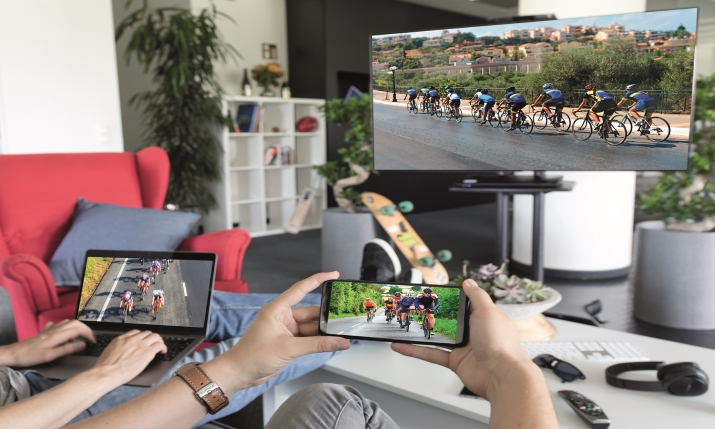Driving a competitive advantage: How IP revolutionises the sports video value chain

By Kristian Mets, head of sales business development, Net Insight.
The demand for live video content doesn’t seem to be slowing down any time soon and live sports is, to a large extent, driving it. Research has shown that 57% of UK sports viewers watch more sports now compared to 2020. The opportunities for media companies to claim a piece (or two) of this pie are huge, especially as there is an ever-growing set of platforms, including over-the-top (OTT), digital and free ad-supported streaming TV (FAST), on which viewers choose to consume their content. However, traditional production, acquisition and distribution workflows relying on satellite are not flexible and efficient enough to support the growth of live sports content.
IP delivers the agility and scalability that media organisations need to innovate across the live video value chain and drive new business models.
Closing the satellite chapter
Media companies relying on satellite transmission are at a crossroads. In the US, the C-band spectrum is used for program distribution of video feeds to broadcast, cable and telco headends and for ad-hoc contribution links. Following an agreement with satellite operators to clear the C-band for 5G use, the Federal Communications Committee (FCC) is on course to take the 5G spectrum below Transponder 14 offline over the coming months.

Kristian Mets, Net Insight
Media companies need to think strategically about their live video production and distribution and ensure they are reaching as many eyeballs as possible across the plethora of digital platforms. Limitations in the availability and more generally the scalability of satellite transmission mean one thing — there isn’t a better time for the media industry to transition to IP than now.
The benefits of IP-driven remote and distributed production
Moving from satellite to IP empowers media companies to leverage innovation at an unprecedented scale and benefit from significant cost and resource efficiencies. IP-driven remote production has been a real game-changer in media, freeing live production from geographical limitations. Not only does remote production eliminate the complex and costly logistics involved in getting large volumes of equipment and personnel from one live sports event to the next, but it allows one production team to support multiple events in a single day.
In a time when viewers are consuming more live sports than ever, including local and niche sports, being able to satisfy and monetise this demand is the recipe for success for media companies. The remote production model drives capex and opex efficiency and creates more revenue opportunities. Additionally, innovation in remote production means viewing experience can be more compelling and engaging than ever. Production teams can use advanced robotics equipment like robotic camera heads that can be controlled remotely from anywhere in the world seamlessly with high accuracy and ultra-low latency, elevating the quality of live sports productions and helping viewers feel they are at the centre of the action.
IP has also enabled the distributed production model by ‘breaking up’ the live production workflow to involve more production facilities and teams across geographies. Enhancing creative collaboration beyond borders and time zones empowers media companies to tap into a broader pool of talent and resources, and deliver better content more efficiently.
Scaling live video with IP-powered acquisition and distribution
Once live video is produced, IP can ensure that the content maximises its value and reaches the right audiences on the right platforms. Traditional acquisition and distribution workflows worked on the ‘one for all’ premise — one live video feed to be distributed to all destinations. This model has obvious limitations, there are only so many content ‘takers’ that can receive a generic live feed.
However, the media and sports landscapes are changing. New players from the streaming and tech world are entering the sports rights competition, raising stakes and making getting ‘digital-ready’ more pressing for media organisations. At the same time, consumers are expecting a compelling cross-platform live sports offering. With sports rights becoming a highly competitive, significantly expensive investment, broadcasters need to ensure they are getting the most bang for their buck.
IP delivers the scalability, flexibility and efficiency media companies need to hit two birds with one stone: ensure their high-value content goes as far and wide as possible but at the same time is hyper-localised to specific audiences, paving the way for further monetisation.
Feed customisation for individual markets includes localised commentators and other elements that make the viewing experience richer, more culturally relevant and more compelling like live game stats, highlights, graphic overlays and pre/post-show content. It provides the layer that makes content interesting and appealing for diverse global audiences and is ultimately the key that opens the door to further revenue opportunities and higher return on investment on what is typically significantly expensive high-profile sports content.
Setting up for success in the IP era
The media companies that are leading the way in IP production and distribution are well-versed to succeed in the competition for live sports content. Not only can they get the most out of their premium sports content by scaling it to more audiences and platforms, but they can also tap into previously niche content to grow their audience base and drive new revenue streams. All this while maintaining ease of use and control of live feeds and delivering super-high-quality content which is adapted to the requirements of diverse markets.
In times like this, when every penny counts and needs to be accounted for, the move to intelligent IP workflows minimises capex and opex in the medium term and increases efficiencies across the value chain. With IP, sports rights owners can take control of their content and its profitability easily and efficiently, and monetise the skyrocketing demand for live sports.

